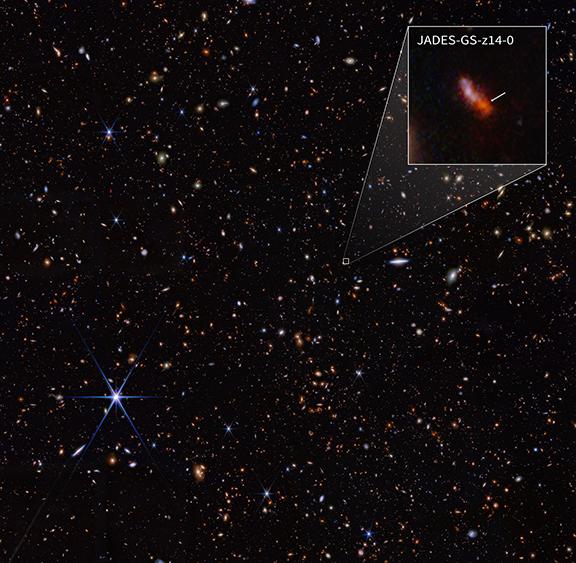CfA Astronomers Help Find Most Distant Galaxy Using James Webb Space Telescope
An international team of astronomers, including CfA scientists, used JWST to find a record-breaking galaxy observed less than 300 million years after the Big Bang.

Cambridge, MA--An international team of astronomers today announced the discovery of the two earliest and most distant galaxies ever seen, dating back to only 300 million years after the Big Bang. These results, using NASA's James Webb Space Telescope (JWST), mark a major milestone in the study of the early Universe.
The discoveries were made by the JWST Advanced Deep Extragalactic Survey (JADES) team. Daniel Eisenstein from the Center for Astrophysics | Harvard & Smithsonian (CfA) is one of the team leaders of JADES and Principal Investigator of the observing program that revealed these galaxies. Ben Johnson and Phillip Cargile, both Research Scientists at CfA, and Zihao Wu, a Harvard PhD student at CfA, also played important roles.
Because of the expansion of the Universe, the light from distant galaxies stretches to longer wavelengths as it travels. This effect is so extreme for these two galaxies that their ultraviolet light is shifted to infrared wavelengths where only JWST can see it. Because light takes time to travel, more distant galaxies are also seen as they were earlier in time.
The two record-breaking galaxies are called JADES-GS-z14-0 and JADES-GS-z14-1, the former being the more distant of the two. In addition to being the new distance record holder, JADES-GS-z14-0 is remarkable for how big and bright it is. “The size of the galaxy clearly proves that most of the light is being produced by large numbers of young stars," said Eisenstein, a Harvard professor and chair of the astronomy department, “rather than material falling onto a supermassive black hole in the galaxy’s center, which would appear much smaller."
The combination of the extreme brightness and the fact that young stars are fueling this high luminosity makes JADES-GS-z14-0 the most striking evidence yet found for the rapid formation of large, massive galaxies in the early Universe.
"JADES-GS-z14-0 now becomes the archetype of this phenomenon,” says Dr. Stefano Carniani of the Scuola Normale Superiore in Pisa, lead author on the discovery paper. "It is stunning that the Universe can make such a galaxy in only 300 million years."
Evidence for surprisingly vigorous early galaxies appeared even in the first JWST images and has been mounting in the first two years of the mission. This trend runs counter to expectations that most astronomers had before the launch of JWST of theories of galaxy formation.
JADES-GS-z14-0 was a puzzle for the JADES team when they first spotted it over a year ago, as it appears close enough on the sky to a foreground galaxy that the team could not be sure that the two were not neighbors. But in October 2023, the JADES team conducted even deeper imaging—five full days with the JWST Near-Infrared Camera on just one field—and used filters designed to better isolate the earliest galaxies.
"We just couldn't see any plausible way to explain this galaxy as being merely a neighbor of the more nearby galaxy,” says Dr. Kevin Hainline, research professor at the University of Arizona.
The galaxy is located in a field where the JWST Mid-Infrared Instrument had conducted an ultra-deep observation. Its brightness at intermediate infrared wavelengths is a sign of emission from hydrogen and even oxygen atoms in the early Universe.
"Despite being so young, the galaxy is already hard at work creating the elements familiar to us on Earth," said Zihao Wu, a co-author on a second paper about this finding, led by Jakob Helton, a graduate student at the University of Arizona.
Emboldened, the team then obtained a spectrum of each galaxy, and confirmed their hopes that JADES-GS-z14-0 was indeed a record-breaking galaxy and that the fainter candidate, JADES-GS-z14-1, was nearly as far away.
A third paper led by Brant Robertson, professor at the University of California-Santa Cruz, and Ben Johnson, studies the evolution of this early population of galaxies. "This amazing object shows that galaxy formation in the early Universe is very rapid and intense,” said Johnson, “and JWST will allow us to find more of these galaxies, perhaps when the universe was even younger. It is a marvelous opportunity to study how galaxies get started."
About the Center for Astrophysics | Harvard & Smithsonian
The Center for Astrophysics | Harvard & Smithsonian is a collaboration between Harvard and the Smithsonian designed to ask—and ultimately answer—humanity's greatest unresolved questions about the nature of the universe. The Center for Astrophysics is headquartered in Cambridge, MA, with research facilities across the U.S. and around the world.
Media Contact
Peter Edmonds
Interim CfA Public Affairs Officer
Center for Astrophysics | Harvard & Smithsonian
+1 617-571-7279
pedmonds@cfa.harvard.edu
Related News
Runaway Stars Reveal Hidden Black Hole In Milky Way’s Nearest Neighbor
NASA's Hubble, Chandra Find Supermassive Black Hole Duo
Event Horizon Telescope Makes Highest-Resolution Black Hole Detections from Earth
CfA Celebrates 25 Years with the Chandra X-ray Observatory
Astronomers Unveil Strong Magnetic Fields Spiraling at the Edge of Milky Way’s Central Black Hole
Black Hole Fashions Stellar Beads on a String
M87* One Year Later: Proof of a Persistent Black Hole Shadow
Unexpectedly Massive Black Holes Dominate Small Galaxies in the Distant Universe
Unveiling Black Hole Spins Using Polarized Radio Glasses
A Supermassive Black Hole’s Strong Magnetic Fields Are Revealed in a New Light
Projects
AstroAI
DASCH (Digital Access to a Sky Century @ Harvard)
For that reason, the DASCH (Digital Access to a Sky Century @ Harvard) team are working to digitize the plates for digital storage and analysis. The process can also lead to new discoveries in old images, particularly of events that change over time, such as variable stars, novas, or black hole flares.
GMACS
For Scientists
Sensing the Dynamic Universe
SDU Website